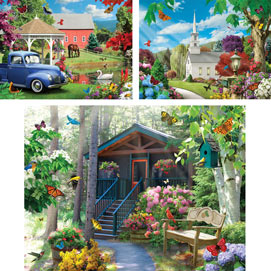
Ocean-themed puzzles are an engaging way to teach children about the ocean. They are a great present for ocean-loving kids. These puzzles include colorful pieces and a little artistic mixing. These puzzles can be used as a way to introduce shapes and colors to children. Plus, this type of puzzle also features a variety of marine creatures that make for great discussion topics.
Beautiful Ocean 100 piece jigsaw puzzle
Ravensburger's Beautiful Ocean 100 jigsaw puzzle may be a good option if you want a puzzle with a tactile challenge. It is incredibly realistic thanks to its 100-piece thick design and lack of glare. This puzzle is ideal for anyone who is new to jigsaws and wants to become familiar with the pieces.
This ocean puzzle is a perfect gift idea for a child that loves the ocean. It features colorful pieces and artistic blending to make it a great visual experience. It features more than 40 marine species. This makes it great for young children who are learning about colors and shapes.

Underwater Paradise
If you've ever wished to live in an underwater paradise, jigsaw puzzles might be something you have considered. These puzzles offer a variety of special cutting features and intricate designs that will both delight and surprise you. There are also a variety of themed puzzles for kids of all ages.
Jellyfish
You'll love the Jellyfish ocean Puzzle if you love jellyfish and oceans. This unique game combines the fun of jigsaw puzzles with a beautiful theme. You'll need to piece together pieces of different sea creatures in order to create the jellyfish body. So that you can advance to the next level, your goal is to make three or more identical tiles.
Ravensburger
Ravensburger puzzles will inspire and excite. They feature intriguing sea creatures and large, sturdy pieces. Whether you prefer large or medium-sized pieces, you can find a suitable ocean puzzle to suit your preference. You may also find a puzzle that can be used in a child's room.
The Ocean Life Supersized Ravensburger Floor Puzzle contains 24 pieces in various sizes. It is easy to wipe clean. This puzzle features large-sized aquatic creatures including clown fish, dolphins and sea life. The puzzle allows children to use their fine motor skills and practice hand coordination while they work.

Melissa & Doug
Children can get involved with building puzzles while learning about ocean life. These puzzles feature 48 extra-thick, colourful pieces and are easy to put together. They are easy to clean and maintain their original appearance. Puzzles are great for encouraging imagination.
Melissa & Doug's ocean-floor puzzle is a good choice for children interested in learning about marine life. Made from thick cardboard, the puzzle contains images of colorful sea creatures. It also comes with an easy-to-transport and store wooden tray. This puzzle is suitable for children aged 6 and above.
FAQ
What are some good hobbies ideas?
Doing something you enjoy is the best hobby. You'll be more motivated to do what you love. It will also be easier to find a reason to stop feeling tired or sick.
There are many hobbies that we all enjoy: gardening, painting and crafts; photography; cooking; sports and games; reading music and film-making; collecting; cycling, walking, dancing and writing; playing instruments and other musical instruments.
Consider volunteering at your local animal shelter, charity shop, hospice, children's hospital or hospice, elderly care home, school center, church, or community center.
Let's say you are looking for something more exciting. You might consider scuba diving or skydiving.
You can spend your time outdoors in many different ways, including spelunking, snowshoe hiking, snowshoe hiking and more. These include caving, cliff diving, cave tubing, abseiling, sea kayaking, rafting, canoeing, climbing, trekking, bushwalking, mountaineering, backpacking, trail running, orienteering, off-road driving, quad biking, motorcycling, motorcycle riding, dirt bike riding, jet boating, hang gliding, hang gliding, parachuting, hang gliding, heli-skiing, ice skating, snowmobiling, snowshoeing, snowshoeing, cross country skiing, downhill skiing, telemark skiing, ski touring, sled dog racing, snowboarding, snowkiting, snowmobiling, spelunking, snowshoe hiking, snowshoeing and many more.
What are some competitive hobbies?
Swimming, running, cycling, golfing and tennis are some of the competitive sports.
They're usually played by people who enjoy physical activity but also provide an opportunity for social interaction.
You will probably find people around you who have the same hobby as you, if you are into physical activity.
This may mean joining a club or group where you meet regularly to play sports together.
Participating in group games, which involve playing alongside others, is another option.
These include soccer (soccer), rugby, netball and hockey.
There are many types of competition.
Some competitions may be held for pure recreational purposes.
Others are used to assess competitors' abilities.
Others are also designed to reward exceptional performance.
In these cases, the winners receive prizes.
Other competitions are meant to test competitors' strength and stamina.
These are known endurance events.
For example, marathon races, triathlons, Ironman Triathlon, etc.
Before competing in these events, athletes train hard.
To prepare them mentally and physically, they will be following a strict training regimen.
They might also have to travel for preparation.
It is important to remember, not all athletes will compete in every type and event.
What are some hobbies that you like?
Hobby Ideas that are great for people who enjoy teaching others.
Hobbies are a great way for you to do what you love and also learn something new.
There are many different types of hobbies, but they all have similar characteristics. These hobbies are often enjoyable and require minimal effort.
These also involve helping others.
Although you might not consider yourself a teacher, there are likely things you can do to help others learn.
So if you want to be more creative in your life, consider starting a hobby where you can use your skills to help others.
What are some enjoyable hobbies for seniors
Senior citizens need to find things they like doing. Senior citizens should keep active through participation in physical and sports activities.
They might be interested in joining clubs that offer similar interests. As they age, this will help them feel less alone.
Senior citizens should keep up to date with the latest trends. They could be interested in fashion, art, music and literature.
Statistics
- Studies show that just six minutes of reading can reduce stress levels by 60 percent. (oberlo.com)
- Much of this decline reflects the fact that teens are less likely to work today than in the past; among employed teens, the amount of time spent working is not much different now than it was around 2005. (pewresearch.org)
- This 100% accurate personality-analyzing hobby quiz discovers your passion based on your characteristics. (quizexpo.com)
- A new survey by Pew Research Center of teens ages 13 to 17 finds that 36% of girls feel tense or nervous about their day every day; 23% of boys say the same. (pewresearch.org)
- In comparison, men in the “no humor” condition were refused 84.6% of the time and were only accepted 15.4% of the time. (time.com)
External Links
How To
How to Start Gardening
Gardening is one the oldest forms. It takes patience, persistence, determination, and perseverance. The first step to starting a garden is to pick a spot where you will grow food. This could be a large plot of land or even just a small area in your backyard. Next, choose what kind of plants you would like to grow. Do you prefer vegetables or flowers? Some people like to grow herbs and others enjoy raising livestock, such as rabbits. Before you decide which crops you will plant, consider the amount of space you have. If your climate is cold, you may decide to plant berries and fruits.
Once you have chosen what you will be planting, you must take some time to prepare your soil. Your plants' success or failure will depend on the soil they are placed in. High quality soil is rich in organic matter, which feeds your plants' roots. Organic matter is made up of leaves, twigs grass clippings, manure and compost. After you have prepared the soil, you will need to add nutrients. You will need different amounts of nutrients depending on which type of plants are being grown. To determine these values, you can use a fertilizer calculator online. There are many fertilizers available so be sure to know what you are purchasing.
After you have prepared your soil, and added the correct nutrients, you will need to wait until your seed germinates. This process usually takes anywhere from 2 weeks to 3 months, depending on the weather and the temperature in your area. Once the seeds have sprouted you will need to water them often. You can endanger your plants if you water them too often or too little. You should ensure that your plants get enough water at regular intervals. Avoid overwatering. Overwatering could lead to root rot as well as fungal diseases. When watering your plants, remember that most plants require less water during the warm summer months than in winter. Some plants must be dried out after being watered. Tomatoes for instance need to remain slightly moist, but not wet. Soggy soil is not good for them. After the flowers have stopped, they must go into dormancy. Dormancy is when plants stop producing new growth and begin storing energy for the next season's harvest. The plant ceases sending signals to its roots to produce food during dormancy. Throughout this time, plants can store energy. However, if the temperatures drop below freezing and there isn't enough sunlight, the plant will go to sleep.
Living in urban areas may restrict the types of plants you can plant. Concrete sidewalks, roads, buildings and parking lots are all common in urban areas. These blocks block sunlight from reaching ground level. Concrete absorbs light and prevents soil below from getting sufficient sun exposure. Many plants can't survive in urban environments due to lack of sunlight. Many plants can still thrive in urban settings. Many trees, perennials, shrubs, as well as shrubs can be adapted to urban living. In addition, many annuals can be grown indoors in containers. Container gardens can be used to grow greenery indoors year-round, no matter what the weather outside.
You are now ready to plant your garden!